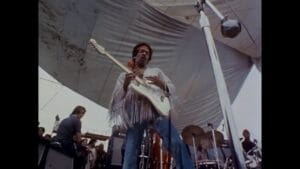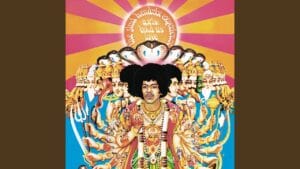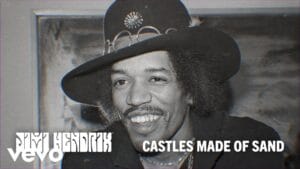James Marshall “Jimi” Hendrix was born on November 27, 1942, in Seattle, Washington. He was an American guitarist, singer, and songwriter who redefined the electric guitar’s role in popular music. Essentially self-taught, Hendrix developed a groundbreaking playing style that fused fuzz, feedback, and controlled distortion into a new language of sound—one that expanded the instrument’s expressive range and cultural impact.
Early Influences
Hendrix’s musical roots ran deep in the blues. He absorbed the phrasing of Muddy Waters, the fire of Elmore James, and the melodic instincts of Curtis Mayfield. His early years backing R&B artists like Little Richard and the Isley Brothers sharpened his rhythm chops and stagecraft, while his fascination with Bob Dylan’s lyricism and Miles Davis’s harmonic daring pushed him toward more experimental terrain.
This fusion of blues tradition and sonic curiosity laid the foundation for a style that would soon explode into something entirely new.
Career Milestones
R&B Apprenticeship
Hendrix began his professional career in the early 1960s, playing backup for R&B artists including Little Richard, Sam Cooke, Curtis Mayfield, Ike Turner, and the Isley Brothers. These years honed his timing, groove, and showmanship.
Much of this early work took place on the so-called chitlin’ circuit—a network of Black venues across the American South and Midwest. The relentless touring and high-energy performances sharpened Hendrix’s stagecraft and deepened his rhythmic instincts, laying the groundwork for the explosive style he would later unleash.
The Jimi Hendrix Experience
Before his breakthrough, Hendrix spent the mid-1960s playing solo gigs and backing R&B acts in New York’s Greenwich Village, drifting between clubs with no clear path forward. It was during one of these performances that Linda Keith, a model and friend of Hendrix, recommended him to Chas Chandler, bassist of The Animals. Chandler caught a set at Café Wha? and was immediately struck by Hendrix’s raw talent and stage presence.
Sensing star potential, Chandler invited Hendrix to London in 1966 and helped him form the Jimi Hendrix Experience with bassist Noel Redding and drummer Mitch Mitchell. Their debut album Are You Experienced (1967) introduced Hendrix’s explosive guitar style to the world, blending blues roots with psychedelic innovation.
Follow-ups Axis: Bold as Love (1967) and Electric Ladyland (1968) expanded his sonic palette, merging studio experimentation with virtuosic playing. These albums showcased his mastery of feedback, layering, and tonal manipulation—pushing rock guitar into new expressive territory.
Band of Gypsys & Woodstock
In 1969, Hendrix formed Band of Gypsys with former army buddy, bassist Billy Cox, and drummer Buddy Miles, marking a shift toward funk, soul, and jazz-rock fusion. The trio’s live album, Band of Gypsys (1970), recorded at the Fillmore East, captured Hendrix’s evolution into a groove-driven improviser—trading psychedelic fire for rhythmic depth and extended jams.
This period also included his legendary performance at Woodstock, where his electrified rendition of “The Star-Spangled Banner” became a defining moment of countercultural expression. Though his mainstream career lasted just a little more than three years, Hendrix’s output was prolific, and his influence immeasurable—reshaping the electric guitar’s role in popular music and expanding its expressive vocabulary.
Playing Style & Technique
Hendrix’s guitar work was rooted in blues but expanded into rock, funk, psychedelia, and jazz. He pioneered techniques with feedback, distortion, and the wah-wah pedal, played right-handed guitars flipped upside down and restrung—contributing to his unmistakable tone and phrasing.
His use of fuzz and modulation effects created swirling soundscapes that redefined what a guitar could do. Tracks like “Purple Haze” and “Voodoo Child (Slight Return)” showcased his mastery of sonic manipulation, while his improvisational depth drew admiration from jazz musicians and rock icons alike.
Gear & Tone
Hendrix’s tone was a blend of raw power and subtle control. He favored Fender Stratocasters, often played through Marshall stacks, and used effects like the Fuzz Face, Uni-Vibe, Octavia, and wah-wah to sculpt his sound. His signal chain was as expressive as his phrasing—capable of everything from crystalline cleans to volcanic distortion.
But gear was only part of the equation. Hendrix’s touch, phrasing, and fearless manipulation of feedback made his tone feel alive—an extension of his voice, not just his hands.
Legacy
Hendrix revolutionized the electric guitar, transforming it from a rhythm instrument into a lead voice capable of unprecedented expression. His fearless experimentation, harmonic sophistication, and improvisational depth continue to inspire musicians across genres—from heavy metal and jazz fusion to hip-hop and electronic music.
He expanded the vocabulary of rock guitar, not just through technique but through tone, texture, and attitude. His recordings remain essential listening for anyone seeking to understand the expressive power of the instrument.
Final Reflection
Jimi Hendrix didn’t just play the guitar—he reimagined it. His recordings didn’t echo the blues; they exploded it into cosmic realms. From the raw fire of “Foxy Lady” to the meditative swirl of “1983… (A Merman I Should Turn to Be),” Hendrix pushed boundaries with every note.
Though his life was brief, his impact was seismic. Hendrix’s legacy lives not just in his recordings, but in every guitarist who dares to bend sound into emotion. His music endures as both history and prophecy—a blueprint for sonic exploration.
He also embodied the spirit of his era—restless, visionary, and deeply human—a sentiment he expressed with poetic clarity:
“When the power of love overcomes the love of power, the world will know peace.” — Jimi Hendrix
Essential Listening
To appreciate Hendrix’s genius is to hear both sides of his artistry—studio precision and live fire. This section highlights definitive recordings that capture his control in the studio and his raw, improvisational power onstage.
Live Performances
Jimi Hendrix’s 1970 Maui performance of “Voodoo Child (Slight Return)” channels volcanic energy, cosmic tone, and blues-rooted fire in a surreal, untethered moment of psychedelic...
Jimi Hendrix’s 1970 Maui performance of “Voodoo Child (Slight Return)” channels volcanic energy, cosmic tone,...
Hendrix's feedback-drenched anthem captured the chaotic spirit of the '60s. His guitar transformed the melody, mimicking rockets and bombs, creating an iconic, wrenching commentary on...
Hendrix's feedback-drenched anthem captured the chaotic spirit of the '60s. His guitar transformed the melody,...
Studio Recordings
A defiant psychedelic anthem from Hendrix, blending raw tone, studio experimentation, and existential freedom into sonic rebellion.
A defiant psychedelic anthem from Hendrix, blending raw tone, studio experimentation, and existential freedom into...
Spanish Castle Magic” hits like a storm—no intro, no restraint. Hendrix turns a teenage venue into sonic myth, riffing with raw precision while the rhythm...
Spanish Castle Magic” hits like a storm—no intro, no restraint. Hendrix turns a teenage venue...
Hendrix’s studio take on “Axis: Bold as Love” blends lyrical vulnerability with cosmic tone — a technicolor ballad of emotion, restraint, and transcendent guitar phrasing.
Hendrix’s studio take on “Axis: Bold as Love” blends lyrical vulnerability with cosmic tone —...
Hendrix’s studio take on “Castles Made of Sand” drifts through reverse guitar swells and quiet melancholy — a psychedelic lullaby built on loss, restraint, and...
Hendrix’s studio take on “Castles Made of Sand” drifts through reverse guitar swells and quiet...






